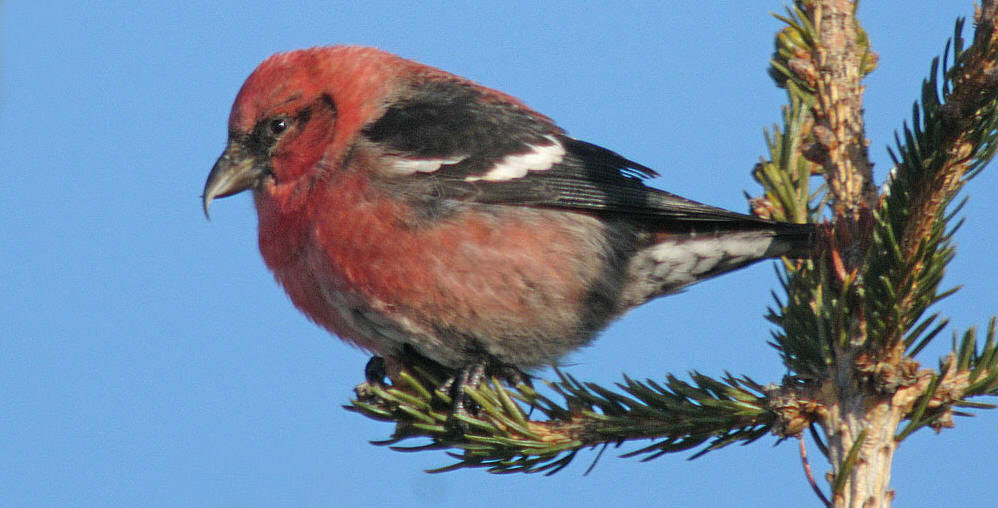|
WINTER FINCH FORECAST 2002-2003
by Ron Pittaway |
|
 |
|
Male White-winged Crossbill on white spruce by
Jean Iron |
|
|
|
Hello Ontbirders, I've been
assessing the seed crops developing on trees and shrubs in central
Ontario north of Toronto. This area is bounded by Lake Ontario to
the south, Georgian Bay to the west, the Ottawa River to the north,
and St. Lawrence River to the east. I asked Ron Tozer in Algonquin
Park for his seed crop assessment. Mike Turner in Haliburton and
Mike Walsh in Muskoka, both with the Ministry of Natural Resources,
also advised me of seed crops in their areas. Even this early in the
season, it's already evident that many trees and shrubs are growing
good to heavy crops of cones, catkins, seeds and berries. Get ready
for a good finch winter. |
|
|
|
Pines: White
Pine is growing a moderate to heavy (not bumper) crop of cones in
most areas. Red Pine is also producing many cones. Perhaps some of
the pine forms of the Red Crossbill will move into Algonquin Park by
late summer and remain there for the winter. Many other species,
such as Red-breasted Nuthatches, will benefit from a good crop of
White Pine cones. |
|
|
|
Spruce: White
Spruce is producing a heavy crop of cones. Good news for
White-winged Crossbills, Pine Siskins and Red-breasted Nuthatches. |
|
|
|
Balsam
Fir: A heavy crop of cones. At one time I didn't think
that the seeds of Balsam Fir were an important winter food for
finches, chickadees and Red-breasted Nuthatches. I thought this
because most of the cones break apart in fall and release their
seeds. However, Dennis Barry of Whitby, Ontario pointed out to me
that hundreds of fir seeds get lodged in the thick crowns of Balsam
Fir, thus providing a lot of food for gleaning winter birds. |
|
|
|
Hemlock: Eastern
Hemlock is growing a good crop of cones, which should attract
White-winged Crossbills and the small-billed form of the Red
Crossbill (sitkensis) and Pine Siskins this winter. |
|
|
|
Tamarack: This
native eastern larch is loaded with cones, which is more good news
for White-winged Crossbills. |
|
|
|
White
Birch: A bumper
crop of seed catkins is developing. If redpolls leave the boreal
forest, they'll have lots to eat in central Ontario, but the crop is
likely good in the north so it's my bet that redpolls will stay
farther north this winter. |
|
|
|
Mountain-ash: Both wild and European Mountain-ashes are
producing heavy crops. Pine Grosbeaks came south last winter, but
they will stay in northern Ontario this winter if mountain-ash crops
are heavy there too. As well, Bohemian Waxwings should remain in the
north this winter. |
|
|
|
Cherries,
maples and many other fruit/seed trees and shrubs are
growing good to heavy crops helped by the fact that there were no
killing frosts during the critical flowering stages. This should
keep Cedar Waxwings and Black Bears happy this summer. An abundance
of seeds also should cause an increase in small mammals because
they'll have lots to eat, perhaps reflected in a year or two by more
Barred and Northern Saw-whet Owls, which are the two most common
owls in central Ontario. |
|
|
|
Finch forecasting is fraught with
unknowns, but I'm reasonably certain that Algonquin Park and central
Ontario will have good numbers of finches this winter. Expect to see
White-winged Crossbills, Red Crossbills, Pine Siskins, Evening
Grosbeaks, and probably some Purple Finches. The heavy birch crop
north of Lake Ontario will stop and hold the redpolls if they come
south. Red-breasted Nuthatches also should be plentiful this winter
in central Ontario. However, there will be lower numbers of finches
if the big seed crop is widespread from Ontario to Nova Scotia. |
|
|
|
Happy winter finch watching, |
|
|
|
Ron Pittaway |
|
16 June 2002
Minden and Toronto, Ontario
E-mail: jeaniron@sympatico.ca |
|
|
|
|
|
|
|
|